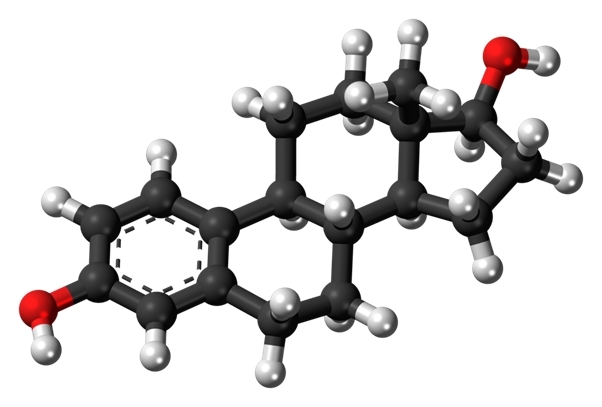

A study supported by FAPESP is investigating the possibility that estrogens inhibit the progression of the disease. The goal is to find medications for the treatment of COVID-19 (Image: Model of 17β-estradiol / Wikimedia Commons)
A study supported by FAPESP is investigating the possibility that estrogens inhibit the progression of the disease. The goal is to find medications for the treatment of COVID-19.
A study supported by FAPESP is investigating the possibility that estrogens inhibit the progression of the disease. The goal is to find medications for the treatment of COVID-19.

A study supported by FAPESP is investigating the possibility that estrogens inhibit the progression of the disease. The goal is to find medications for the treatment of COVID-19 (Image: Model of 17β-estradiol / Wikimedia Commons)
By José Tadeu Arantes | Agência FAPESP – Men and women each account for roughly the same proportion of people diagnosed with COVID-19 globally, but most patients with severe disease (i.e., those who are hospitalized and those who eventually die from the disease) are male. According to Global Health 50/50, an independent organization hosted by University College London in the UK, “In most countries, available data indicate that men have been upwards of 50% more likely to die following diagnosis than women”.
This statement is corroborated by up-to-date statistics for New York City in the US and by a study conducted in China, according to which “the male gender is a risk factor for higher severity and mortality in patients with COVID-19, independent of age and susceptibility”.
Based on this epidemiological finding and on data from scientific literature, a large multidisciplinary team of researchers in the state of São Paulo, Brazil, is investigating the role of estrogens, the main female hormones, in physiological protection against the novel coronavirus.
The project is “Evaluation of compounds with therapeutic potential for SARS-CoV-2: focus on estrogen-related compounds, autophagy modulators and ACE-2”. The principal investigator is Rodrigo Portes Ureshino, a professor at the Federal University of São Paulo (UNIFESP). The project is supported by FAPESP under the aegis of the call for proposals entitled “Fast-track supplements for projects against COVID-19”.
“Previous studies focusing on SARS-CoV [the coronavirus that caused the 2002-04 SARS epidemic] pointed to sex differences in terms of infection and progression of the disease, suggesting that men were more susceptible and that estrogens could be associated with a degree of physiological protection in women. We want to test whether the same is true of SARS-CoV-2, the novel coronavirus, in order to identify compounds with therapeutic potential,” Ureshino told Agência FAPESP.
He and his group have completed the literature review portion and begun the experimental stage of the project. “We’ve infected cell lines with wild strains of the virus and will now use this model to test over 40 compounds with estrogenic activity to observe the results,” he said.
The experiment is being conducted in a Biosafety Level III (BSL-3) facility at UNIFESP, led by Professor Mário Janini, a collaborator on the project.
Among the compounds to be tested, Ureshino highlighted 17β-estradiol (the most abundant circulating estrogen in humans), tamoxifen (a selective estrogen receptor modulator), and genistein (a phytoestrogen). All three have been used successfully in other viral disease models.
In addition to this strictly therapeutic focus that involves the testing of compounds with potential for use in the treatment of COVID-19, the project also has a molecular dimension. In this case, the aim is to investigate the expression of the receptor for ACE-2 (angiotensin-converting enzyme 2), the protein to which the virus binds to invade human cells. “We know that expression of ACE-2 is augmented in patients with high blood pressure, a high-risk group for COVID-19, and that this favors cell penetration by the virus, so we’re studying ACE-2 overexpression in different cell types,” Ureshino said.
A preprint of an article by the group on this topic (“SARS-CoV-2 and the possible connection to ERs, ACE-2 and RAGE: focus on susceptibility factors”) is available for download. The first author is Roberta Sessa Stilhano, a professor in the Santa Casa de São Paulo Medical School (FCM-SCSP).
The coauthors include Carla Máximo Prado, a professor at UNIFESP who studies the process of pulmonary inflammation, and researchers at institutions elsewhere, such as the University of California, Davis (USA) and the University of Cambridge (UK).
“The article discusses the correlations among three factors: ACE-2, estrogen receptors, and inflammation,” Stilhano said. “Thus, in addition to the metabolic pathways relating to ACE-2 and estrogens, we also describe the pathways for RAGE [the receptor for advanced glycation end-products], which is associated with inflammation. We believe a better understanding of these pathways will improve prospects for the treatment of COVID-19.”
In addition to the UNIFESP team, Ana Cristina Breithaupt-Faloppa and Luiz Felipe Pinho Moreira, researchers at the University of São Paulo’s Medical School (FM-USP), are also participating in the project.
Republish
The Agency FAPESP licenses news via Creative Commons (CC-BY-NC-ND) so that they can be republished free of charge and in a simple way by other digital or printed vehicles. Agência FAPESP must be credited as the source of the content being republished and the name of the reporter (if any) must be attributed. Using the HMTL button below allows compliance with these rules, detailed in Digital Republishing Policy FAPESP.





